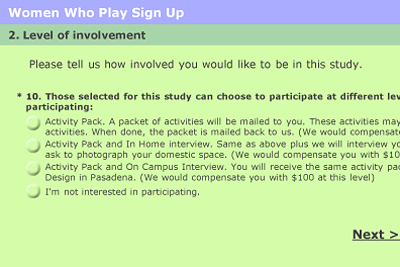Project and
Methods:
Recruiting:
Screening for ambivalence:
Offering varying levels of participation

A page from the online screener for Women Who Play. Women were allowed to choose their level of involvment.
By offering a variety of levels to participate, and allowing the subjects to self-screen, new possibilities are afforded. Super Studios have historically offered only one level of participation; activity packs (if being used) and an interview. The scheduling of in-home or in-facility has been at the researchers discretion or convenience. By knowing in advance how the subject wants to participate it may be possible to judge their level of interest. This would be useful, because that ambivalent participants generally return less useful results and drain resources. Tuuli Mattelmäki, writing about a probe practice that values co-design and dialogue, lists several ways personal contact can be used to build relationships between designers and participant and how that can lead to better involvment.
HP--in a follow up study after the Tween project--first had participants complete activity packs. Then used those to screen out uninteresting subjects who would not be included in interviews. After conducting interviews, they again screened out those that would not be participating in hosted parties. They found probes to be a useful tool for judging interest versus ambivalence. For HP it was more cost effective to send probes to screen participants. In a small study, where conducting interviews is virtually cost-free and building probes can be quite expensive, it is not. However, as discussed in the probe section, it is advantageous to have the probes completed before the interviews.
 A graph of interview times from Women Who Play. Those in gray were conducted in facailty, the others in the women's homes.
A graph of interview times from Women Who Play. Those in gray were conducted in facailty, the others in the women's homes.
Which brings us back to offering potential participants several levels of interaction. In this study, four of the five women who asked to only receive activity packs did not complete them (the study originally had fifteen women, but only ten fully participated.) While some of this may be due to mailing difficulties (see below), one participant refused to except the package from the post office three times. It is clear that those who choose this option had the least amount of interest in the study. As a group, the women in this study who choose to receive activity packs and have in-facility interviews completed fewer of the probes and gave significantly shorter interviews--some as much as fifty percent shorter than the in-home average. It was the women who choose to have activity packs and in-home interviews who where the most interested in the study and participated the most.
In future studies it might be advantageous to offer a similar tiered level of involvement and then only choose those subjects who want to participate at the highest level. In this way they could be screened against ambivalence without conducting interviews or sending out probes.
<<previous next>>
 A page from the online screener for Women Who Play. Women were allowed to choose their level of involvment.
A page from the online screener for Women Who Play. Women were allowed to choose their level of involvment. A graph of interview times from Women Who Play. Those in gray were conducted in facailty, the others in the women's homes.
A graph of interview times from Women Who Play. Those in gray were conducted in facailty, the others in the women's homes.